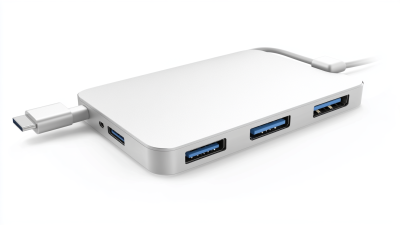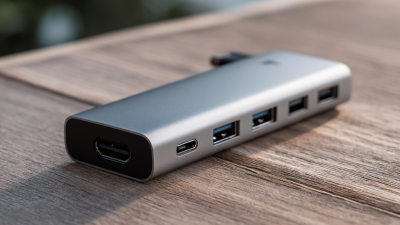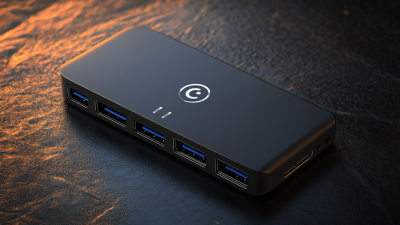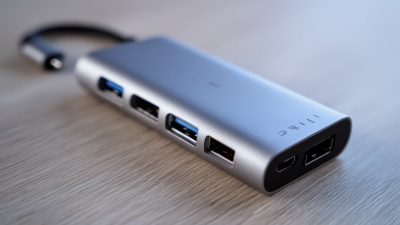
-
Home
-
Products
-
About Us
-
OEM&ODM
-
News
-
Contact Us
Inquiry
Form loading...

As technology continues to evolve, the demand for versatile and efficient connectivity solutions has surged, making the USB-C multiport hub an indispensable accessory for both professionals and everyday users. According to a report by Grand View Research, the global USB hub market is projected to reach $4.3 billion by 2025, driven largely by the increasing adoption of USB-C technology across various devices. A well-chosen USB-C multiport hub can enhance productivity, streamline workflows, and expand connectivity options by allowing users to connect multiple devices simultaneously, including laptops, smartphones, and monitors. However, with so many options available, selecting the right USB-C multiport hub tailored to individual needs can be challenging. This guide will explore essential factors to consider when choosing the perfect USB-C multiport hub, ensuring optimal performance and convenience for your tech ecosystem.

When it comes to selecting the right USB-C multiport hub, understanding device compatibility is crucial. As more devices, like the latest smartphones and laptops, transition to USB-C connections, it's important to verify whether the hub will work seamlessly with your specific devices. For example, if you own the latest iPhone models, which now feature a USB-C port, finding a hub that supports data transfer and power delivery can enhance your experience significantly. Make sure to examine the specifications and ensure that the hub you choose is compatible with your device's requirements.
Moreover, different multiport hubs offer various functionalities, such as HDMI output, additional USB ports, and even SD card readers, which can accommodate varied user needs. Whether you're looking to connect your laptop to a TV or expand your desktop setup by adding multiple peripherals, knowing your device's compatibility with these ports will help you select the most effective hub. Look for products that not only match your devices but also provide the features that will optimize your workflow and enhance productivity.
| Hub Features | Device Compatibility | Port Types | Power Delivery | Data Transfer Speed |
|---|---|---|---|---|
| HDMI, USB-A, USB-C | Laptops, Tablets | 1 x HDMI, 2 x USB-A 3.0, 1 x USB-C | Up to 100W | Up to 5 Gbps |
| VGA, USB-C, Ethernet | Desktops, Laptops | 1 x VGA, 1 x USB-C, 1 x Ethernet | Up to 60W | Up to 1 Gbps |
| SD Card Reader, USB-A | Cameras, Laptops | 1 x SD Card, 2 x USB-A 2.0 | N/A | Up to 480 Mbps |
| 4K HDMI, USB-C, USB-A | Laptops, Monitors | 1 x 4K HDMI, 1 x USB-C, 2 x USB-A 3.1 | Up to 100W | Up to 10 Gbps |
When selecting a USB-C multiport hub, understanding your connectivity needs is paramount. Recent studies indicate that over 60% of users prioritize the availability of multiple USB ports for peripheral devices, such as external hard drives, mice, and keyboards (Statista, 2023). Additionally, HDMI output is crucial for those who require high-definition video transfer, with approximately 40% of users needing to connect their laptops to monitors or projectors for presentations or extended workspace setups.
Another vital consideration is the inclusion of power delivery (PD) capabilities. Research shows that nearly 70% of tech users prefer hubs that can deliver power back to their devices while simultaneously connecting to peripherals (Gartner, 2023). This feature ensures that your devices remain charged during use, especially when on the go. Furthermore, consider the need for SD card readers or Ethernet ports, which can significantly enhance performance in professional settings. Prioritizing these functions will lead to a more efficient and streamlined work experience.
When choosing the right USB-C multiport hub, one of the most critical aspects to evaluate is its power delivery and charging capabilities. A good hub should support sufficient wattage to charge your laptop while simultaneously maintaining connectivity with other devices. It's crucial to look for specifications that confirm the hub can deliver adequate power; many devices require higher wattage for efficient charging, especially for laptops. This can ensure that you won't compromise performance while multitasking.
Additionally, consider the integration of power management features within the hub. Advanced USB hubs may incorporate technologies that enhance power distribution across multiple ports, minimizing downtime caused by slow charging. As described in recent discussions on energy systems, optimizing power quality is central to efficient performance, whether it's in charging electric vehicles or using a USB multiport hub. Therefore, selecting a hub with robust power delivery not only enhances your device connectivity but also fundamentally supports your energy management needs in a digital environment.
When selecting a USB-C multiport hub, design factors such as build quality and portability play a critical role in tailoring the device to your specific needs. High build quality is essential not only for longevity but also for ensuring reliable performance. A hub made from durable materials, such as aluminum or reinforced plastic, can withstand daily wear and tear, making it a suitable choice for frequent travelers or those who tend to move their devices around often.
Additionally, features like tangle-free cables, non-slip surfaces, and adequate heat dissipation contribute to the overall durability and user experience of the hub.
Portability is another vital consideration. A compact and lightweight design makes it easier to carry a USB-C multiport hub alongside other devices without adding significant bulk. Hubs with a slim profile can easily fit into bags or even pockets, which is particularly advantageous for people on the go.
It’s also important to assess the arrangement and spacing of the ports; well-placed connections prevent interference while allowing multiple devices to be plugged in simultaneously. By weighing these design factors thoughtfully, users can ensure they choose a multiport hub that not only meets functional requirements but also aligns with their lifestyle.
When selecting the right USB-C multiport hub, it's crucial to consider both price and brand reputation to make an informed decision. According to a recent report by Grand View Research, the USB hub market is projected to reach $2.0 billion by 2026, with a compound annual growth rate (CAGR) of 9.6% from 2020 to 2026. This growth indicates a competitive landscape where consumer choices are abundant, but it also highlights the importance of aligning brand reliability with your specific needs.
Brand reputation plays a significant role in ensuring longevity and performance of electronic accessories. A survey by Consumer Reports indicates that 70% of consumers prefer to purchase from brands with a history of positive customer service and product quality. Brands like Anker and Satechi have consistently received high ratings for their USB-C hubs, attributed to their durability, functionality, and customer support. Thus, investing in a well-reviewed brand can not only provide peace of mind but also potentially save you money in the long run by avoiding inexpensive, lower-quality alternatives that may need frequent replacement.





